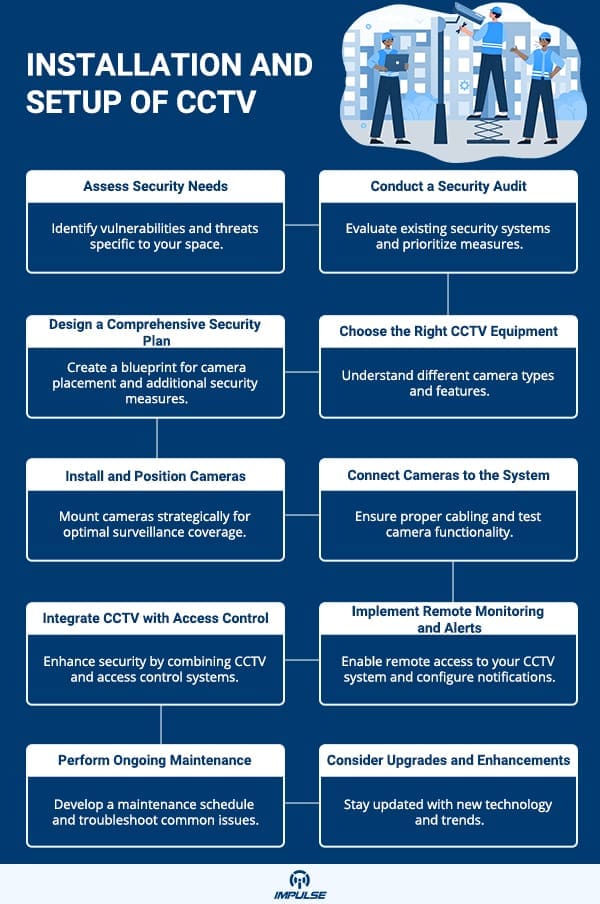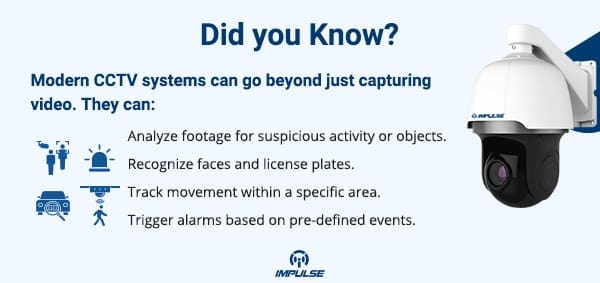In today’s world, security is paramount, especially in commercial and institutional spaces where valuable assets and sensitive information are at stake. Closed Circuit Television (CCTV) plays a crucial role in enhancing security measures. By providing real-time monitoring and recording, the best CCTV camera brand helps deter criminal activities, improve response times, and provide valuable evidence in case of incidents. It’s like having your watchful eye on every corner of your premises, except without the need for sleep or coffee breaks.
Overview of Security Coverage and Surveillance Systems
When it comes to security coverage, it’s not just about slapping a few cameras at random spots and calling it a day. An effective Video surveillance system requires strategic planning and placement. A comprehensive security coverage plan encompasses the entire premises, considering both indoor and outdoor areas. This includes main entrances, parking lots, hallways, common areas, and any other locations that could potentially be targeted. It’s like creating a customized security blanket that keeps your space snug and protected.
1. Assessing Security Needs and Risks
1.1 Identifying Vulnerabilities and Threats
Before diving into the world of CCTV, it’s essential to identify potential vulnerabilities and threats specific to your commercial or institutional space. This involves evaluating factors like the nature of your business, location, previous security incidents, and even the surrounding environment. Think of it as playing detective to uncover any weak points that could be exploited by mischievous individuals.
1.2 Conducting a Security Audit
Once vulnerabilities and threats are identified, conducting a security audit helps in prioritizing security measures. It involves assessing existing security systems, such as access control systems, alarms, and physical barriers. This audit allows you to determine the gaps in your current security coverage and helps in developing a more robust plan to prevent any unwelcome surprises.
1.3 Determining Security Objectives and Requirements
Every commercial or institutional space has unique security objectives and requirements. Whether it’s preventing theft, ensuring employee safety, or safeguarding sensitive data, clearly defining your security objectives helps in tailoring your CCTV system accordingly. It’s like creating a personalized security wishlist that makes your space as impenetrable as Fort Knox.
Also Read: Top 5 Outdoor Network Cameras for Businesses: Deter Crime and Monitor Property
2. Designing an Effective CCTV System
2.1 Formulating a Comprehensive Security Plan
Armed with the knowledge of vulnerabilities and security objectives, it’s time to formulate a comprehensive security plan that incorporates the CCTV system. This plan should outline the number of cameras needed, their positioning, and any additional security measures required. It’s like drawing up a master blueprint that ensures every nook and cranny is under the watchful eyes of your cameras.
2.2 Determining Camera Placement and Coverage Areas
Camera placement is crucial to maximize surveillance coverage. It involves strategically positioning cameras to cover vulnerable areas, high-traffic zones, and blind spots. It’s like arranging a family portrait, but instead of capturing smiles, you’re capturing potential threats.
2.3 Evaluating Lighting and Environmental Factors
Lighting and environmental factors can greatly impact the effectiveness of CCTV cameras. Things like glare, shadows, extreme temperatures, and weather conditions need to be considered when choosing camera types and their placement. It’s like considering the perfect lighting and ambiance for a Hollywood blockbuster, except in this case, the plot revolves around security.
Also Read: Futureproof Your Business: A Smart Guide to Choosing Video Surveillance for Tomorrow
3. Selecting the Right CCTV Equipment
3.1 Understanding Different Types of CCTV Cameras
Not all CCTV cameras are created equal. There are various types, like dome cameras, bullet cameras, and PTZ (Pan-Tilt-Zoom) cameras, each with their unique features and capabilities. Understanding the differences will help you choose the appropriate camera types for different areas of your commercial or institutional space. It’s like picking the right tool for the job, except instead of fixing things, you’re fixing your security concerns.
3.2 Choosing the Appropriate Camera Features
Camera features can make or break the effectiveness of your CCTV system. Important features to consider include resolution, night vision capabilities, motion detection, and remote access. It’s like shopping for a smartphone but instead of selfies and apps, you’re concerned with capturing crisp footage of potential wrongdoers.
3.3 Considerations for DVRs and NVRs
Alongside cameras, Digital Video Recorders (DVRs) and Network Video Recorders (NVRs) are the brains behind your CCTV operation. These devices store and manage the video footage captured by the cameras. Considerations like storage capacity, remote access capabilities, and scalability should guide your choice of DVRs or NVRs. It’s like picking the perfect storage unit that can hold all your recorded memories, except in this case, those memories involve security footage.
Impulse CCTV is your go-to source for expert advice and top-notch surveillance equipment. With our wide range of CCTV solutions, you can find the perfect fit for your commercial or institutional space.
4. Installing and Setting Up CCTV Cameras
4.1 Preparing for Camera Installation
Installing CCTV cameras may sound like a daunting task, but with the right preparation, it can be a breeze. Before you begin, make sure you have a clear understanding of your security needs and the areas you want to cover. Take the time to map out the layout of your space and identify the vulnerable spots that require surveillance. This way, you can ensure you have the right number and type of cameras for optimal coverage.
4.2 Mounting and Positioning Cameras
Now comes the fun part – mounting and positioning the cameras. Start by selecting the right spots to mount them, ensuring they have a wide field of view without any obstructions. Whether you choose wall mounts or ceiling mounts, make sure they are securely attached. Remember, nobody wants a camera crashing down on their head during a crucial moment!
4.3 Connecting Cameras to the System
With your cameras in place, it’s time to connect them to the surveillance system. This typically involves running cables from each camera to the central recording device or network video recorder (NVR). Ensure that the cables are neatly organized and protected to prevent any potential tripping hazards or damage. Once all the connections are made, test each camera to ensure they are properly transmitting video and capturing clear footage.

5. Integrating CCTV with Access Control Systems
5.1 Benefits of Integrating CCTV and Access Control
Having CCTV and access control systems working together is like having Batman and Robin fighting crime side by side. By integrating these two systems, you can enhance the security of your commercial or institutional space. CCTV cameras can provide visual evidence of any access control events, while access control systems can trigger camera recordings based on specific access events. This integration allows for more effective monitoring and a better understanding of who has access to your premises.
5.2 Understanding Integration Options
When it comes to integrating CCTV with access control systems, you have a few options to explore. You can choose between hardware-based integration, where the systems directly communicate with each other using interfaces, or software-based integration, which involves using a unified management platform to control both systems. Consider the specific requirements of your space and the capabilities of your existing systems to determine the best integration option for you.
5.3 Configuring CCTV and Access Control Integration
Configuring the integration of CCTV and access control systems requires a bit of technical know-how, but fear not! Most reputable manufacturers provide detailed instructions or even support services to guide you through the process. You’ll need to establish the necessary communication protocols and set up rules for triggering camera recordings based on access events. Take your time, follow the instructions, and you’ll soon have a well-integrated security system that would make Sherlock Holmes proud.
6. Implementing Remote Monitoring and Alert Systems
6.1 Remote Monitoring Technologies and Options
Gone are the days when you had to physically be on-site to monitor your CCTV system. Thanks to remote monitoring technologies, you can keep an eye on your space from virtually anywhere. There are various options available, such as mobile apps, web-based interfaces, and even cloud-based platforms. Choose a solution that suits your needs and provides the flexibility to access your CCTV system remotely.
6.2 Setting Up Remote Access to CCTV System
To set up remote access to your CCTV system, you’ll typically need to configure your network settings and ensure you have a stable internet connection. This may involve setting up port forwarding or using a virtual private network (VPN) for added security. Once everything is properly set up, you can grab your smartphone, sip a Piña Colada on a tropical beach, and still keep a watchful eye on your premises.
6.3 Configuring Alerts and Notifications
Nobody wants to spend all day staring at a CCTV monitor, waiting for something exciting to happen. That’s where alerts and notifications come to the rescue. Most modern CCTV systems allow you to configure alerts for specific events, such as motion detection or unauthorized access. You can choose to receive notifications via email, SMS, or push notifications on your mobile device. Just be prepared for a sudden adrenaline rush when you see that notification pop up!

7. Ongoing Maintenance and Upgrades for CCTV Systems
7.1 Developing a Maintenance Schedule
Maintaining your CCTV system doesn’t have to be a headache. By developing a regular maintenance schedule, you can ensure that your cameras and recording equipment are always in top shape. This might involve checking cable connections, cleaning camera lenses, and updating firmware regularly. Don’t forget to include a reminder to feed your cameras some delicious biscuits every now and then (kidding!).
7.2 Troubleshooting Common Issues
Despite your best efforts, sometimes issues may arise with your CCTV system. Before panicking, take a deep breath and remember you’re a tech-savvy genius! Common problems like blurry footage, network connectivity issues, or power failures can often be resolved with a little troubleshooting. Consult your system’s manual or reach out to the manufacturer’s support team for guidance and assistance.
7.3 Considering Upgrades and Future Enhancements
Technology never stops advancing, and neither should your CCTV system. Keep an eye on the latest developments in the industry and consider upgrading or adding new features to your system as needed. This might include higher resolution cameras, advanced video analytics, or cloud storage options. Embrace the future and keep your security system on the cutting edge!
Now that you have a step-by-step setup guide for CCTV and security coverage, you can confidently embark on your mission to safeguard your commercial or institutional space. Remember, whether you’re protecting a bustling office or a cozy library, a well-planned and properly maintained security system is your trusty sidekick in the fight against potential threats.
Conclusion
By following this step-by-step setup guide, you have gained a comprehensive understanding of CCTV and security coverage for commercial and institutional spaces. You now have the knowledge to assess security needs, design an effective system, select the right equipment, install and set up cameras, integrate with access control systems, implement remote monitoring, and ensure ongoing maintenance. Remember, well-designed and properly implemented CCTV installation services can significantly enhance the security of your premises and provide peace of mind. Stay vigilant, keep up with technology advancements, and regularly review and update your security measures to ensure continued effectiveness. With these steps, you are ready to create a safe and secure environment for your business or institution.
Impulse CCTV offers a comprehensive range of surveillance solutions for commercial and institutional spaces. Our team of professionals is committed to delivering reliable and cutting-edge CCTV systems tailored to your specific requirements.


